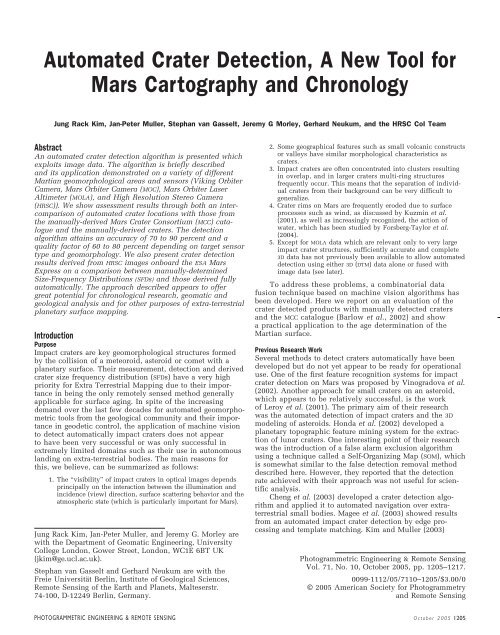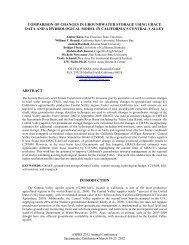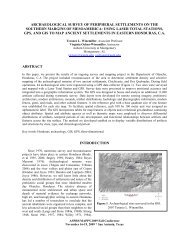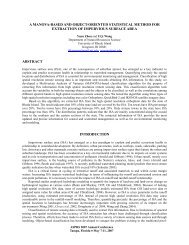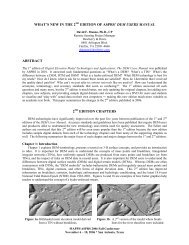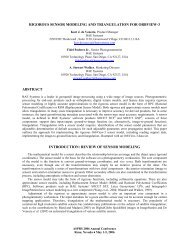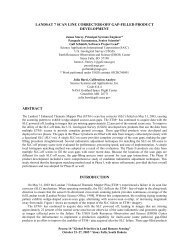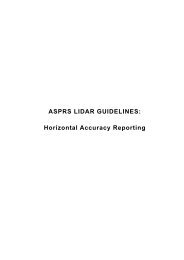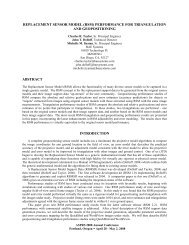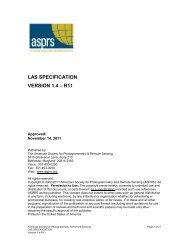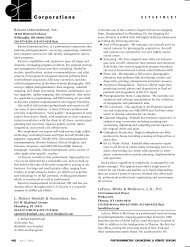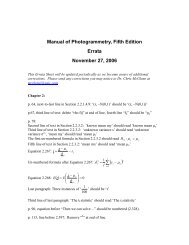Automated Crater Detection, A New Tool for Mars ... - asprs
Automated Crater Detection, A New Tool for Mars ... - asprs
Automated Crater Detection, A New Tool for Mars ... - asprs
Create successful ePaper yourself
Turn your PDF publications into a flip-book with our unique Google optimized e-Paper software.
<strong>Automated</strong> <strong>Crater</strong> <strong>Detection</strong>, A <strong>New</strong> <strong>Tool</strong> <strong>for</strong><br />
<strong>Mars</strong> Cartography and Chronology<br />
Jung Rack Kim, Jan-Peter Muller, Stephan van Gasselt, Jeremy G Morley, Gerhard Neukum, and the HRSC CoI Team<br />
Abstract<br />
An automated crater detection algorithm is presented which<br />
exploits image data. The algorithm is briefly described<br />
and its application demonstrated on a variety of different<br />
Martian geomorphological areas and sensors (Viking Orbiter<br />
Camera, <strong>Mars</strong> Orbiter Camera (MOC), <strong>Mars</strong> Orbiter Laser<br />
Altimeter (MOLA), and High Resolution Stereo Camera<br />
(HRSC)). We show assessment results through both an intercomparison<br />
of automated crater locations with those from<br />
the manually-derived <strong>Mars</strong> <strong>Crater</strong> Consortium (MCC) catalogue<br />
and the manually-derived craters. The detection<br />
algorithm attains an accuracy of 70 to 90 percent and a<br />
quality factor of 60 to 80 percent depending on target sensor<br />
type and geomorphology. We also present crater detection<br />
results derived from HRSC images onboard the ESA <strong>Mars</strong><br />
Express on a comparison between manually-determined<br />
Size-Frequency Distributions (SFDs) and those derived fully<br />
automatically. The approach described appears to offer<br />
great potential <strong>for</strong> chronological research, geomatic and<br />
geological analysis and <strong>for</strong> other purposes of extra-terrestrial<br />
planetary surface mapping.<br />
Introduction<br />
Purpose<br />
Impact craters are key geomorphological structures <strong>for</strong>med<br />
by the collision of a meteoroid, asteroid or comet with a<br />
planetary surface. Their measurement, detection and derived<br />
crater size frequency distribution (SFDs) have a very high<br />
priority <strong>for</strong> Extra Terrestrial Mapping due to their importance<br />
in being the only remotely sensed method generally<br />
applicable <strong>for</strong> surface aging. In spite of the increasing<br />
demand over the last few decades <strong>for</strong> automated geomorphometric<br />
tools from the geological community and their importance<br />
in geodetic control, the application of machine vision<br />
to detect automatically impact craters does not appear<br />
to have been very successful or was only successful in<br />
extremely limited domains such as their use in autonomous<br />
landing on extra-terrestrial bodies. The main reasons <strong>for</strong><br />
this, we believe, can be summarized as follows:<br />
1. The “visibility” of impact craters in optical images depends<br />
principally on the interaction between the illumination and<br />
incidence (view) direction, surface scattering behavior and the<br />
atmospheric state (which is particularly important <strong>for</strong> <strong>Mars</strong>).<br />
Jung Rack Kim, Jan-Peter Muller, and Jeremy G. Morley are<br />
with the Department of Geomatic Engineering, University<br />
College London, Gower Street, London, WC1E 6BT UK<br />
(jkim@ge.ucl.ac.uk).<br />
Stephan van Gasselt and Gerhard Neukum are with the<br />
Freie Universität Berlin, Institute of Geological Sciences,<br />
Remote Sensing of the Earth and Planets, Malteserstr.<br />
74-100, D-12249 Berlin, Germany.<br />
2. Some geographical features such as small volcanic constructs<br />
or valleys have similar morphological characteristics as<br />
craters.<br />
3. Impact craters are often concentrated into clusters resulting<br />
in overlap, and in larger craters multi-ring structures<br />
frequently occur. This means that the separation of individual<br />
craters from their background can be very difficult to<br />
generalize.<br />
4. <strong>Crater</strong> rims on <strong>Mars</strong> are frequently eroded due to surface<br />
processes such as wind, as discussed by Kuzmin et al.<br />
(2001), as well as increasingly recognized, the action of<br />
water, which has been studied by Forsberg-Taylor et al.<br />
(2004).<br />
5. Except <strong>for</strong> MOLA data which are relevant only to very large<br />
impact crater structures, sufficiently accurate and complete<br />
3D data has not previously been available to allow automated<br />
detection using either 3D (DTM) data alone or fused with<br />
image data (see later).<br />
To address these problems, a combinatorial data<br />
fusion technique based on machine vision algorithms has<br />
been developed. Here we report on an evaluation of the<br />
crater detected products with manually detected craters<br />
and the MCC catalogue (Barlow et al., 2002) and show<br />
a practical application to the age determination of the<br />
Martian surface.<br />
Previous Research Work<br />
Several methods to detect craters automatically have been<br />
developed but do not yet appear to be ready <strong>for</strong> operational<br />
use. One of the first feature recognition systems <strong>for</strong> impact<br />
crater detection on <strong>Mars</strong> was proposed by Vinogradova et al.<br />
(2002). Another approach <strong>for</strong> small craters on an asteroid,<br />
which appears to be relatively successful, is the work<br />
of Leroy et al. (2001). The primary aim of their research<br />
was the automated detection of impact craters and the 3D<br />
modeling of asteroids. Honda et al. (2002) developed a<br />
planetary topographic feature mining system <strong>for</strong> the extraction<br />
of lunar craters. One interesting point of their research<br />
was the introduction of a false alarm exclusion algorithm<br />
using a technique called a Self-Organizing Map (SOM), which<br />
is somewhat similar to the false detection removal method<br />
described here. However, they reported that the detection<br />
rate achieved with their approach was not useful <strong>for</strong> scientific<br />
analysis.<br />
Cheng et al. (2003) developed a crater detection algorithm<br />
and applied it to automated navigation over extraterrestrial<br />
small bodies. Magee et al. (2003) showed results<br />
from an automated impact crater detection by edge processing<br />
and template matching. Kim and Muller (2003)<br />
Photogrammetric Engineering & Remote Sensing<br />
Vol. 71, No. 10, October 2005, pp. 1205–1217.<br />
0099-1112/05/7110–1205/$3.00/0<br />
© 2005 American Society <strong>for</strong> Photogrammetry<br />
and Remote Sensing<br />
PHOTOGRAMMETRIC ENGINEERING & REMOTE SENSING October 2005 1205
suggested a similar crater detection method, but employing<br />
texture analysis and ellipse fitting on the DTM and optical<br />
image. A search of the non-refereed literature shows there<br />
are a number of techniques being developed but no quantitative<br />
in<strong>for</strong>mation on their accuracy, reliability, or completeness<br />
is reported.<br />
Algorithms<br />
The overall procedure consists of three stages First (see<br />
Figure 1), a focusing stage defines target edge segments in<br />
so-called Regions of Interest (ROIs). These “preliminary crater<br />
edges” are then organized to locate optimal ellipses in a<br />
second processing step. Optimal circles, or ellipses (due to<br />
the perspective distortion of spacecraft images) <strong>for</strong> impact<br />
craters are then evaluated using a fitness function and<br />
refined and verified by template matching. Finally, false<br />
alarms (false detections) are removed using a neural networkbased<br />
false crater recognition scheme.<br />
In the following sub-sections, further details, albeit<br />
limited by space, are provided of these individual stages.<br />
Focusing<br />
When applying the first stage, there are usually too many<br />
connected edge segments in an optical image. A focusing<br />
strategy using a texture classification and edge direction<br />
analysis is there<strong>for</strong>e used here to reduce the search space.<br />
Grey level co-occurrence matrices (GLCMs) (Haralick, 1979)<br />
are widely used to extract texture properties, and these<br />
texture properties can be simply classified using a k-means<br />
Figure 1. Schematic diagram of overall work flow and<br />
processing steps <strong>for</strong> the Kim-Muller (KM) automated<br />
crater detection system.<br />
clustering into a ROI. The texture properties of GLCMs which<br />
are employed in this work were moments, contrast, and<br />
homogeneity using a window of 5 to 12 pixel size depending<br />
on the minimum size of the desired target crater. The<br />
ROIs of contiguous craters frequently overlap so that a splitting<br />
process based on a simple morphological distance trans<strong>for</strong>mation<br />
was applied as follows:<br />
where D X is the Euclidean distance trans<strong>for</strong>mation of point X<br />
from the nearest boundary p, s is the structuring element of a<br />
morphological filter, usually of size 3 pixels by 3 pixels, X�<br />
are all points within distance d max from the nearest boundary,<br />
where d max are decided by the size of GLCM window, S is the<br />
skeleton by the distance trans<strong>for</strong>mation, � i is the i th application<br />
of a binary dilation where the number of dilations i<br />
depend on the value of d max, and R_R is the reconstructed ROI.<br />
In this equation, we employed an Euclidean distance<br />
trans<strong>for</strong>mation using grayscale morphology (Huang and<br />
Mitchell, 1994) to split attached ROIs during the texture<br />
classification stage, which are then reconstructed into their<br />
original shape by recursive binary dilation.<br />
Here, an edge is localized by its ROI, which is defined<br />
through a GLCM texture classification. This GLCM-based<br />
texture analysis is applied iteratively to some ROIs, which<br />
are larger than a predefined critical size, as these could be<br />
candidates <strong>for</strong> composite craters (Figure 2b).<br />
Edge thresholding was per<strong>for</strong>med by the following<br />
procedures within a localized edge area. As shown in Figure<br />
3, which shows a simulated crater image derived from a<br />
generalized 3D crater model using a Phong surface shading<br />
model, there are four edge segments: Seg1, Seg2, Seg3, and<br />
Seg4. The real crater rim edge is usually defined as the<br />
boundary between the illuminated and shadowed areas, such<br />
as Seg1 and Seg2. An evaluation of the edges in the four<br />
detected regions based on this criterion can be made by<br />
looking at the maxima (M x1, M x2 in Figure 3b) of the crater<br />
edge segments and the extent of the crater edge rim.<br />
As is typical, the edge magnitude and direction can be<br />
defined as:<br />
w � arctan( (2)<br />
where Gx is the x gradient of intensity, and Gy is the y<br />
gradient of intensity.<br />
Here, the maxima refer to the points where the angles<br />
between solar illumination and an edge direction are perpendicular<br />
as shown in Figure 3a, and consequently, the edge<br />
magnitudes (Ie) are at a maximum in each edge segment<br />
(Figure 3b).<br />
The extent of a crater edge can usually be defined by<br />
the edge direction range �90° from maxima. There<strong>for</strong>e, the<br />
edge lines in the crater rim parts can be traced and extracted<br />
by employing the following method. An initial estimation of<br />
the radius, r, can be replaced by a mean dimension of ROI<br />
(ri) using a moment analysis as follows<br />
Gy )<br />
Gx L major � A<br />
s � [X t Dx (p) � min7p<br />
� X7<br />
x�R<br />
: DX (p) � dmax] R_R � (S � s) i � (S � s)� p �s<br />
I e � sqrt(G x 2 � Gy 2 )<br />
r i � (L major � L min or)/2.0<br />
12M20 12M02 , Lmin or �<br />
M00 A M00 Mij � a<br />
xk�R a<br />
i j<br />
xkyk yk�R 1206 October 2005 PHOTOGRAMMETRIC ENGINEERING & REMOTE SENSING<br />
(1)<br />
(3)
Figure 2. Examples of ROI definition in selected crater areas. (a) Original image (MOC WA<br />
M0300343), (b) ROIS by texture analysis, (c) Preliminary crater rim detection results.<br />
For all of the edge pixels with r which are estimated<br />
from (Equation 3) in the � (edge direction) space, the maximum<br />
edge intensity point in each �� interval is detected<br />
from the edge direction of the maxima to �90°. This procedure<br />
can be used to detect “seed points” (see Figure 3c). By<br />
applying region growing to these seed points using a four-way<br />
connectivity within a fixed edge magnitude, the extent of the<br />
preliminary crater rim edges can be precisely defined as<br />
illustrated in Figure 2c. See Kim et al. (2004) <strong>for</strong> several<br />
examples of the robustness of this algorithm with a large<br />
range of different illumination angles.<br />
Edge Organization<br />
The preliminary crater rims are defined in the first focusing<br />
stage. However the edges of the preliminary crater rims need<br />
to be organized into generalized shapes, particularly optimal<br />
ellipses or circles from the input arbitrary edge lines so that<br />
consequent verification stages using the parameters of the<br />
conic sections (i.e., radius and center point) can be easily<br />
applied.<br />
Impact craters on geometrically corrected images of<br />
planetary surfaces are generally circular features, so that<br />
the eccentricity in any target image is calculable given<br />
the image acquisition geometry. Exceptional cases are<br />
(a) (b) (c)<br />
(a) (b) (c)<br />
Figure 3. Edge <strong>for</strong>mation geometry <strong>for</strong> specific illumination conditions and its<br />
application to crater rim extraction. (a) Simulated crater image showing illumination<br />
condition perpendicular to maximum edge intensity, (b) Edge <strong>for</strong>mation<br />
geometry on crater rim and maxima, (c) Extraction of crater rims from crater<br />
center points.<br />
(a) Rare elliptical impact craters (eccentricity �1.1) are<br />
produced when the impact angles are low relative to the<br />
horizontal. These elliptical impact craters <strong>for</strong>m approximately<br />
5 percent of all kilometer sized craters <strong>for</strong>med on<br />
<strong>Mars</strong>, Venus, and the Moon (Bottke et al., 2000); (b) The<br />
<strong>for</strong>eshortening of a circle into an ellipse by the oblique<br />
view from a framing camera (Viking imagery) or by nonoptimal<br />
choice of interline time in a pushbroom sensor;<br />
and (c) More complex distortions which can be produced<br />
through the uneven motion of a pushbroom sensor (e.g., as<br />
described <strong>for</strong> the MOC Narrow Angle camera by Kirk et al.,<br />
2003), resulting in slightly non-elliptical shapes. However,<br />
it should be noted that the majority of such distorted craters<br />
can be suitably modeled as conic sections with a marginal<br />
eccentricity value. In case (b) the orientation and eccentricity<br />
are known a priori.<br />
The most widely applied edge organization method <strong>for</strong><br />
circle or ellipse detection is the Hough trans<strong>for</strong>mation. There<br />
are a number of modified versions <strong>for</strong> efficient detection of<br />
ellipses or circles such as those proposed by Yuen et al.<br />
(1989) and Olson (1998). However, from our experience,<br />
none of these methods appear to be sufficiently robust to<br />
guarantee the reliable detection of impact craters from a set<br />
of preliminary crater rim edges. Hence, we addressed this<br />
PHOTOGRAMMETRIC ENGINEERING & REMOTE SENSING October 2005 1207
Figure 4. Edge organization schematics.<br />
problem using conic section fitting and graph based edge<br />
organization as shown schematically in Figure 4.<br />
The edge organization stage is a consecutive evolution<br />
process. Starting from crater rim edges, edge pairs are then<br />
<strong>for</strong>med into edge primitives which are then verified from<br />
edge pairs or edge arcs (single edge sets) to <strong>for</strong>m a set of<br />
graph nodes. Finally conic sections are fitted to the cycles of<br />
these edge primitive nodes within the graph.<br />
First, a possible edge pair map is constructed using the<br />
following conditions:<br />
Max(Six,Siy) � Max(Sjx,Sjy) � 7 Cei � Cej7 (4)<br />
where (S ix,S iy) and (S jx,S jy) are the geometrical x, y dimensions<br />
of edge segment i, j, and Ce i, Ce j are the center locations<br />
of edge segments i, j. Equation 4 means that an edge<br />
pair is accepted if the sum of its geometrical dimension is<br />
smaller than the distance between center points. If an edge<br />
pair e(i,j) is possible through condition (Equation 4), the<br />
interior angle, � in of that edge pair is checked as follows (see<br />
Figure 5a; Kim and Kim, 2001).<br />
uin � cos �1 ¡<br />
IM(i) �<br />
°<br />
¡ uin � ut IM(j)<br />
0 ¡ IM(i)0 � 0 ¡ IM(j)0 ¢<br />
where IM(i), IM(j) are the vectors of the intersection point I<br />
of edge pair e(i, j), and mid-point of edge i, j and � t is the<br />
threshold value <strong>for</strong> the interior angle, usually taken as 135°.<br />
A fitness function, conceptually illustrated in Figure 5b<br />
is introduced to evaluate the ratio of target edge points which<br />
is covered by a fitted conic section. An eccentricity check is<br />
then used to assess the reliability of the fitted ellipse. This<br />
consists of a process to construct a node of the edge graph in<br />
the organization step. If the following two conditions, known<br />
as the eccentricity constraint and the fitness constraint <strong>for</strong> the<br />
(5)<br />
(a) (b)<br />
Figure 5. Schematic diagram showing the geometry of<br />
the intersection angle (� in) of edge i,j (a) and the fitness<br />
function (b):<br />
fitted conic section, are satisfied, then an edge pair, e(i,j), is<br />
deemed to <strong>for</strong>m an “edge primitive”<br />
Ecce(i,j) � Eccth Fite(i,j) � Fitth Fite(i,j) � ax a (T(x,y) � B(x,y))/ ax a B(x,y)<br />
y<br />
y<br />
B(x,y) � b(x,y) � s<br />
(6)<br />
where Ecce(i,j) is the eccentricity of edge pair e(i,j), Eccth and<br />
Fitth are threshold values of eccentricity and fitness, T(x,y)is the<br />
thresholded edge image which was processed from the previous<br />
crater rim extraction process, b(x,y) is the binary image of<br />
the fitted conic section, and s is the structuring element of<br />
binary dilation at size ns, which itself depends on the radius (r)<br />
of the fitted conic section, usually 0.1r to 0.2r in pixels.<br />
After selection from several conic section fitting methods,<br />
two algorithms were principally employed in our work. One<br />
is the Direct Least Squared (DLS) fitting method (Fitzgibbon<br />
et al., 1999), and the other uses conic fitting by optimal<br />
estimation (OE) (Kanazawa and Kanantani, 1996). A detailed<br />
description of these algorithms is beyond the scope of this<br />
article; interested readers are advised to consult the above<br />
references. Both algorithms appear to be reliable even with<br />
quite noisy data, with the OE fitting scheme showing the<br />
highest accuracy with relatively short arcs, as are frequently<br />
observed in Martian crater rims. However, the CPU cost of the<br />
OE covariance tensor approach and iterative renormalization<br />
is more expensive compared with the DLS fitting scheme.<br />
There<strong>for</strong>e, the DLS fitting scheme was employed in edge<br />
organization as the default method. In the final fitting stage to<br />
find the best conic section from different crater candidates, OE<br />
is used. If both methods fail, the circle fitting method of<br />
Thomas and Chan (1989), which is based on a regression<br />
<strong>for</strong>mula to extract the circle radius and the center point from<br />
irregularly spaced points, is employed with the assumption<br />
that the image is already adjusted <strong>for</strong> <strong>for</strong>eshortening or nonunity<br />
aspect ratio through geometric correction.<br />
All edge primitives are <strong>for</strong>med from the potential edge<br />
pairs e(i,j) and edge arcs, which are also verified by the<br />
fitness ratio in Equation 6. Then, the edge primitives are<br />
used to <strong>for</strong>m the nodes of a graph and all the possible edge<br />
primitives between graph nodes are checked. At all graph<br />
nodes, conic sections are fitted once more and the intersection<br />
ratios of the fitted circles or ellipses and fitness are<br />
examined to identify graph edges by these two conditions:<br />
En(i) � En(j)<br />
En(i) � En(j) � Op th<br />
Fit e(i,j) � Fit th<br />
1208 October 2005 PHOTOGRAMMETRIC ENGINEERING & REMOTE SENSING<br />
(7)
where En(i) are the enclosed parts by node i, En(j) are the<br />
enclosed parts by node j, Op th is the threshold overlap value<br />
(usually 0.5), and Fit th is the thresholded value of fitness,<br />
usually taken as 0.3.<br />
If both conditions are satisfied, the edges between nodes<br />
are connected, so that they <strong>for</strong>m a unidirectional graph.<br />
Then, all possible cycles are detected as shown schematically<br />
in Figure 6c. Among all of these possible cycles, the<br />
best-matched cycle is selected by the chosen conic section<br />
fitting process and fitness function. Then, the longest nodes<br />
of that cycle are removed from other cycles. This is an<br />
iterative process based on the hypothesis that the longest<br />
edge of any impact crater should not be shared by any other<br />
impact craters, such that a repeat detection of the same<br />
crater by another graph cycle is prevented. From this we<br />
obtain the best-fit conic section <strong>for</strong> all edges and combination<br />
of edges (see examples in Figure 6d and e).<br />
Refinement and Verification<br />
To assess the preliminary ellipses, conic sections are<br />
again fitted to the edge points of each ellipse by optimal<br />
estimation, and the fitness is evaluated once more <strong>for</strong> each<br />
ellipse. If the fitness value is higher than a pre-specified<br />
threshold value (usually 0.4), the ellipse is considered as a<br />
potential crater boundary. This additional refinement step<br />
is necessary because as seen in Figure 7a, the outlines of<br />
the crater rims are sometimes not correctly matched with<br />
the finally fitted ellipse. The final verification stage uses<br />
template matching at several fixed radii and center point<br />
ranges with different margins. It is also considered here as<br />
an internal verification stage. As we already have estimated<br />
(a) (b) (c)<br />
(d) (e)<br />
the approximate size of the detected crater candidates<br />
through the previous edge organization stage, it is possible<br />
to examine the correlation value between a predefined<br />
template and the detected crater candidates. First, the<br />
predefined synthetic crater images are selected <strong>for</strong> the<br />
relevant illumination conditions (sun azimuth angle is used<br />
here) as the detected crater candidate image. Then around<br />
the center of the crater candidates, which we refer to as the<br />
core (Figure 7b), templates of different sizes are applied<br />
and correlation values with the target image patch, are<br />
checked. This could be a very time consuming process,<br />
however, as we already know the approximate radius and<br />
center of the target crater, unacceptable CPU times <strong>for</strong> this<br />
stage are avoided.<br />
From the correlation values resulting from the applied<br />
templates, a maximum value is chosen <strong>for</strong> each crater<br />
candidate. If this value is higher than some predefined<br />
threshold value (Corr th � 0.6 usually), the verification process<br />
is deemed successful. Then, the template size and center of<br />
the correlation are extracted which yields more accurate<br />
crater center locations and corresponding radii (Figure 7c).<br />
However, <strong>for</strong> some craters, where the target crater has<br />
some irregular features such as a flat-bed floor or eroded<br />
rim, the template based verification is not suitable because<br />
the correlation value is too low. In such cases, the candidate<br />
crater rim edge would not be correctly defined, and<br />
exact resizing and location of center points is not feasible.<br />
In such cases, the Gruen (1985) image matching scheme,<br />
which has been shown by many authors to be the best<br />
solution <strong>for</strong> the registration between distorted image patches,<br />
is introduced to address geometrical distortions instead<br />
Figure 6. Schematic diagram<br />
and example of edge organization<br />
using a graph theoretic<br />
technique. (a) Labeled edges;<br />
(b) Unidirectional graph from<br />
(a); (c) Cycle detection<br />
process; (d) conic sections<br />
from Cycle (1) node 4-5-6, (2)<br />
2-3-4-5-6, (3) 1-2-3-4-5-6, (4)<br />
2-3-4-6, (5) 1-2-3-4-6, (6) 1-2-<br />
3-6, (7) 9-10-12; (e) Selection<br />
of best fitted conic sections<br />
on cycle (3) 1-2-3-4-5-6, cycle<br />
(7) 9-10-12, and two other<br />
single node conic sections.<br />
PHOTOGRAMMETRIC ENGINEERING & REMOTE SENSING October 2005 1209
(a) (b)<br />
(c)<br />
Figure 7. Example showing the application of template matching to crater cores. (a) Be<strong>for</strong>e<br />
applying template, (b) Core in crater (r � 3 pixels), (c) After template based verification<br />
and refinement.<br />
of simple template matching. The correlation values and<br />
eigenvalues of the Gruen image matcher on the target<br />
craters with various sizes and shapes are illustrated in<br />
Table 1. The empirical eigenvalue threshold chosen <strong>for</strong> the<br />
Gruen template matching is 150 after resizing the inputs to<br />
a radius of 100 pixels to ensure a sufficient numbers of<br />
points <strong>for</strong> template matching of crater targets under any<br />
image and illumination conditions. This provides a good<br />
solution <strong>for</strong> verifying large craters. However, the boundary<br />
rim refinement is not possible in this case, as with simple<br />
template matching method <strong>for</strong> small craters. Instead of rim<br />
refinement, only center point adjustment using shift values<br />
from the results of applying the image matcher can be<br />
extracted.<br />
False <strong>Detection</strong> Removal by Eigencrater and Neural Network<br />
One serious drawback of these algorithms is that there<br />
could be a large number of false detections which result<br />
from crater-like features, such as valleys, shadows, small<br />
volcanoes, and scratches (<strong>for</strong> digitized film products). For<br />
these morphologically similar features, correlation values<br />
with a template can be much higher than our threshold<br />
value of 0.6. To address such problems, we employ the<br />
method of eigencrater construction (Turk and Pentland,<br />
TABLE 1. EXAMPLE TEMPLATE MATCHING RESULTS OF CRATER TARGETS<br />
TOGETHER WITH VALUES OF THE DERIVED CROSS-CORRELATION AND ADAPTIVE<br />
LEAST SQUARES MAXIMUM EIGENVALUES OF THE VARIANCE-COVARIANCE<br />
MATRIX<br />
1991) and recognition by neural networks, which was<br />
originally developed <strong>for</strong> human face recognition using the<br />
following steps which are illustrated in Figure 8.<br />
The main concept behind Turk and Pentland’s scheme<br />
is the compression of image in<strong>for</strong>mation into eigenspace<br />
from the original image space by:<br />
Figure 8. Illustration of the false detection removal<br />
scheme.<br />
1210 October 2005 PHOTOGRAMMETRIC ENGINEERING & REMOTE SENSING
� i � � i � W<br />
M<br />
C � 1<br />
M a<br />
T T<br />
�n� n � AA<br />
n�1<br />
L � AA T<br />
where � i is the i th intensity matrix of a sample crater, � i<br />
is the i th intensity matrix of the rescaled crater, � is the<br />
intensity matrix of mean crater from the set of � i, C is the<br />
covariance matrix, and L is an M � M matrix.<br />
Then, the eigencraters in the new eigenspace can be<br />
determined as follows:<br />
M<br />
ul � a vlk�k k�1<br />
where � l is the eigenvector of L (from Equation 10), u l is the<br />
l th eigencrater and M is the desired image dimension, l � 1,<br />
...., M. (refer to Figure 8 <strong>for</strong> examples)<br />
These procedures require a trans<strong>for</strong>mation from image<br />
(row by column) dimension to M dimensional eigenspace.<br />
Then, a template can be compared with pre-defined true<br />
and false craters using extracted eigencrater components<br />
and weight values without the need <strong>for</strong> pixel-by-pixel<br />
comparison. Moreover the recognition scheme becomes<br />
robust against noise and the variation of illumination present<br />
from one image to the next.<br />
The new image template can be classified by trans<strong>for</strong>ming<br />
into eigencrater space as follows:<br />
T<br />
vk � uk(�new � W),k � 1 p M<br />
T<br />
�new � [v1,v2 p vM] (8)<br />
(9)<br />
(10)<br />
where � new is the input crater, � k is the weight vector of a<br />
new image, and � new is the pattern vector of all input craters.<br />
Which means that the characteristic of a new template can<br />
be compressed into (� 1, � 2 ...� M) coefficients, which can<br />
be readily processed using a neural network.<br />
After this classification, the next problem addressed<br />
is the training vector labeling of crater and non-crater<br />
classes. Our approach is similar to Sung and Poggio’s<br />
(1998) modeling method using a k-means clustering algorithm.<br />
Figure 8 shows defined crater and non-crater patterns<br />
using eigencraters. In this example, three classes<br />
of crater features and four non-crater classes are reconstructed<br />
by the automatic detection process without a<br />
verification stage, and 121 samples are manually selected.<br />
A back propagation neural network was then trained using<br />
these labeled training vectors. In a real application with a<br />
number of sample images, it shows a good efficiency (the<br />
detection ratio of false craters �85 percent, Figure 9).<br />
One drawback with this approach is that re-training is<br />
usually required <strong>for</strong> different sensors.<br />
<strong>Crater</strong> <strong>Detection</strong> with MOLA DTMS<br />
The output from the detection process based on a high<br />
resolution DTM such as MOLA could be required <strong>for</strong> verification<br />
or as a source of complementary data. The detail<br />
obtained with this detection process is similar to that of<br />
crater detection using optical images. The difference in<br />
this DTM crater detection algorithm is as follows: (a) ROIs<br />
are defined from high slope areas instead of texture analysis,<br />
(b) ridge and channel points (Wood, 2003) are used to substitute<br />
edge lines from optical images, and (c) the verification<br />
process uses DTM templates. A result is shown in<br />
Figure 10b, and assessment is discussed in the next section.<br />
Results and Assessments<br />
The automatic detection methods were applied to various<br />
sensors and different geomorphological environments<br />
on <strong>Mars</strong>. These final products have been evaluated by<br />
visual inspection, as well as quantitative assessments made<br />
through comparisons with the MCC catalogue and manually<br />
detected crater ellipses. Finally, an inter-comparison of<br />
Size Frequency Distributions (SFDs) is shown <strong>for</strong> manually<br />
derived crater locations with those derived using this<br />
algorithm.<br />
Assessment Scheme<br />
For quantitative assessment, quality assessment factors<br />
(Shufelt and McKeown, 1993), originally developed <strong>for</strong><br />
building detection work are introduced as follows:<br />
Branching_Factor �<br />
TP<br />
Quality_Percentage � 100<br />
(11)<br />
TP � FP � FN<br />
where True Positive (TP) stands <strong>for</strong> when both data sets<br />
(detected crater and comparison data set) classify the area as<br />
being part of a crater, True Negative (TN) when both data<br />
sets classify the area as being part of the background, False<br />
Positive (FP) when the detected data set classifies the area as<br />
a crater, but the comparison data set classifies it as background<br />
and False Negative (FN) when the detected data set<br />
FP<br />
TP<br />
<strong>Detection</strong>_Percentage � 100<br />
TP � FN<br />
TP<br />
(a) (b) (c)<br />
Figure 9. Example of neural network and eigenspace-based false detection removal. (a)<br />
original image, (b) be<strong>for</strong>e verification, (c) after verification.<br />
PHOTOGRAMMETRIC ENGINEERING & REMOTE SENSING October 2005 1211
classifies the area as background while the comparison data<br />
set classifies it as a crater.<br />
<strong>Detection</strong> Results <strong>for</strong> Sensors<br />
The detection ratio <strong>for</strong> Viking Orbiter images (Figure 10a),<br />
which is tested using a few images, is a little lower<br />
(approximately 3 to 4 percent) than <strong>for</strong> MOC WA images.<br />
However, in spite of the low contrast of the VO image, the<br />
algorithm works well and satisfactorily detects even shallow<br />
craters.<br />
Several examples of crater detection on MOC WA (200 m)<br />
and HRSC (12.5 m) images, are shown in Figure 10 and<br />
Figure 11. Overall, the detection ratio of relatively small<br />
impact craters (8 � r � 60 pixels) is excellent, but large or<br />
multi-ringed structured craters show relatively poor detection<br />
accuracy. However, it should be noted that the MCC<br />
catalogue, which is complete <strong>for</strong> diameters �5 km, already<br />
includes in<strong>for</strong>mation on most, if not all of these larger<br />
craters. A quantitative assessment of the detection results<br />
on MOC WA images such as those shown in Figure 10c<br />
through 10f using the MCC Barlow sets and manually<br />
measured data sets are shown in Table 2. Global crater<br />
databases at HRSC resolution do not exist, so the assessment<br />
of the detection result, which are shown partly in Figure<br />
11 were per<strong>for</strong>med using manual measurements (Table 3).<br />
As seen in Table 2, crater detection on MOC WA images<br />
appears to have a very high reliability. We believe that the<br />
detection ratio (8 � r � 60 pixels) is sufficiently high such<br />
(a) (b) (c)<br />
(d) (e) (f)<br />
Figure 10. <strong>Crater</strong> detection examples <strong>for</strong> craters of various sizes and shapes on Viking<br />
Orbiter, MOC and MOLA. Note that heavily eroded craters are not currently detected.<br />
(a) <strong>Crater</strong> detection on Viking Orbiter image f718a20, (b) <strong>Crater</strong> detection on MOLA DEM<br />
(Arabia Terra, 256m/pixel resolution), (c) <strong>Crater</strong> detection on MOC WA image M0102418,<br />
(d) <strong>Crater</strong> detection on MOC WA image M0900109. (e) <strong>Crater</strong> detection on MOC WA image<br />
M0300749, (f) <strong>Crater</strong> detection on MOC WA image M0203967.<br />
that it can be employed as a practical tool. In the small<br />
crater size range (3 � r � 8 pixels), quality percentage is<br />
lower than the potential critical value <strong>for</strong> practical applications<br />
(about 80 percent; B. Mayer, personal communication,<br />
2004) which is because false detection recognition schemes<br />
using neural networks do not appear to work well <strong>for</strong> craters<br />
with small radii.<br />
The HRSC crater detection ratio appears to be considerably<br />
lower than <strong>for</strong> the case of MOC images. The reason <strong>for</strong><br />
this lower quality percentage is that there appear to be a<br />
number of false alarms that were not fully removed. The<br />
oblique viewing geometry of HRSC sensors or morphological<br />
undulations at fine resolution can result in the distortion of<br />
a small crater shape which cannot currently be effectively<br />
discriminated against using the current false crater removal<br />
scheme, which employs neural networks and eigencraters.<br />
For MOLA DTM-based crater detection, our analysis<br />
showed a detection ratio of 73 percent <strong>for</strong> large craters<br />
(r � 4 km) compared with manual measurements. Even<br />
though craters are detected, the correct radius is frequently<br />
not determined. An improved verification method based on<br />
some other invariant properties might be a solution and is<br />
currently under investigation.<br />
Discussion<br />
It should also be noted that a number of parameter values<br />
had to be determined empirically and used to optimize the<br />
detection ratios in both the MOC and HRSC imagery. Table 4<br />
1212 October 2005 PHOTOGRAMMETRIC ENGINEERING & REMOTE SENSING
shows a summary of all these parameters and their typical<br />
values. The precise choice of these values is not so crucial<br />
<strong>for</strong> detection accuracy if the false crater removal scheme is<br />
working successfully which is because our approach is to<br />
detect all possible crater candidates during the focusing and<br />
organization stages using generous thresholds, and only to<br />
remove false detections at the verification stage. However,<br />
(a) (b)<br />
(c) (d)<br />
Figure 11. <strong>Crater</strong> detection results on HRSC images of Claritas Fossae (Orbit 68, 24.3°-21.0° S, 254.9°-<br />
259.3° E) and Olympus Mons (Orbit 37, 17.0°-19.1° N, 225.9°-227.8° E). (a) <strong>Crater</strong> detection result on<br />
Claritas Fossae, Orbit 68 nadir image HRSC (6,180 by 8,000 pixel subset, 1,424 craters detected), (b)<br />
<strong>Crater</strong> detection result on Olympus Mons, Orbit 37, HRSC nadir image, (8,927 by 10,094 pixel subset,<br />
3,860 craters are detected), (c) Close-up of Orbit 68 image (715 by 483 pixel size, black box area in<br />
(a)), (d) Close-up of Orbit 37 image (606 by 489 pixel size, black box area in (b)).<br />
two parameters, the thresholding value of the fitness function<br />
and the correlation value at the verification stage, need to be<br />
carefully chosen in highly undulating areas or HRSC images<br />
as shown in Table 4. Otherwise, false negative detections are<br />
increased.<br />
Currently, our algorithm has several drawbacks. First of<br />
all, the algorithm appears to fail on very rough and undu-<br />
PHOTOGRAMMETRIC ENGINEERING & REMOTE SENSING October 2005 1213
TABLE 2. IMPACT CRATER DETECTION RATIO FROM AN INTER-COMPARISON<br />
WITH MCC AND MANUAL MEASUREMENTS IN 14 RANDOM MOC WA IMAGES<br />
SUCH AS THOSE SHOWN IN FIGURE 10 INCLUDING A VERY LARGE RANGE OF<br />
DIFFERENT GEOMORPHOLOGICAL TYPES INCLUDING VALLEYS, FRACTURES,<br />
ATTACHED CRATERS, UNDULATING AREAS, AND ERODED CRATERS<br />
Manual Measurements<br />
MCC<br />
(Barlow) Small Size Large Size Total<br />
True positively 60 298 80 378<br />
detected crater<br />
numbers<br />
False positively * 45 7 52<br />
detected crater<br />
numbers<br />
False negatively 11 42 11 53<br />
detected crater<br />
numbers<br />
<strong>Detection</strong> percentage 85% 87.6% 87.9% 87.7%<br />
Branching factor –– 0.15 0.09 0.15<br />
Quality percentage –– 77.4% 81.6% 78.3%<br />
Small size: R � 8 pixels, Large Size: 8 � R � 60 pixels<br />
*False positive has no meaning <strong>for</strong> the MCC inter-comparison,<br />
because MCC data sets do not aim to catalogue all craters in a target<br />
area. Also, true negative has no meaning <strong>for</strong> individual crater<br />
detection.<br />
lating areas, as seen in Figure 12a, because these include<br />
many false crater detections, and the neural network-based<br />
verification method is not reliable enough to remove the<br />
majority of false alarms. Additionally, composite impact<br />
craters are frequently mis-detected. As yet, we have no<br />
solution <strong>for</strong> this, because there are few image clues to split<br />
connected edges, as illustrated in Figure 12b. Also, there<br />
are many images which are noisy or hazy; manual exclusion<br />
of those images is currently necessary.<br />
Even though all the algorithms appear to work well,<br />
some erroneous detection results are inevitable. We are<br />
there<strong>for</strong>e developing a cross-verification process between<br />
detections from optical images, i.e., overlapping MOC images<br />
or HRSC stereo pairs, and/or DTMs, to generate more extensive<br />
and reliable crater maps. This process should be operational<br />
in the near future if an automated co-registration procedure<br />
using bundle block adjustment between optical images and<br />
DTMs, such as MOLA can be implemented.<br />
Example Application: <strong>Crater</strong> SFD Analysis <strong>for</strong> Surface Age Dating<br />
The locations and physical characteristics (such as radii) of<br />
all the craters automatically detected in the volcanic caldera<br />
of Olympus Mons (see Figure 11c) were used to produce a<br />
crater Size-Frequency Distribution (SFD) <strong>for</strong> different geological<br />
units (see Figure 13a, taken from Neukum et al., 2004).<br />
The SFDs derived from manual measurements kindly pro-<br />
vided by Stephanie Werner (Free University Berlin) are<br />
plotted alongside results from the automated method (indicated<br />
as KM here) in Figure 13b and c, respectively. When<br />
comparing the manually derived crater SFDs with the<br />
automatically detected distribution using the KM method two<br />
major differences become apparent: (a) The KM method<br />
showed significant differences <strong>for</strong> craters with smaller<br />
diameters down to 30 meters compared with the manual<br />
method, and (b) the cumulative distribution derived by the<br />
automatic detection method shows the characteristic bend<br />
at small-diameters significantly earlier than the manually<br />
derived distribution. Both characteristics appear to be<br />
caused by a lower percentage of HRSC detection results <strong>for</strong><br />
smaller craters due perhaps to the ineffective false crater<br />
removal scheme as previously described. Additionally, not<br />
TABLE 3. IMPACT CRATER DETECTION RATIO ASSESSMENTS ON HRSC IMAGE WITH MANUAL MEASUREMENT IN TWO SAMPLE AREAS<br />
High Undulating Area Low Undulating Area<br />
(part of Orbit 37) (part of Orbit 68)<br />
Small Size Large Size Total Small Size Large Size Total<br />
True positively detected crater number 119 6 125 60 16 76<br />
False positively detected crater number 20 1 21 15 4 19<br />
False negatively detected crater number 52 2 54 7 3 10<br />
<strong>Detection</strong> percentage 69.6% 75% 69.8% 89% 84.2% 88.3%<br />
Branching factor 0.17 0.17 0.17 0.25 0.25 0.25<br />
Quality percentage 62.3% 67% 62.5% 73.1% 69.5% 72.3%<br />
Small size: R � 8 pixels, Large Size: 8 � R � 60 pixels.<br />
TABLE 4. DETAILS OF FACTORS EMPLOYED IN THE CRATER DETECTION<br />
ALGORITHM<br />
Factor Description Typical Value Remarks<br />
d max Distance Depends on the<br />
parameter from size of GLCM � GLCM<br />
RoI boundary window window<br />
� t Threshold value of 135 degrees<br />
the interior angle<br />
between an edge<br />
pair to <strong>for</strong>m an<br />
edge primitive<br />
Opth Threshold value of<br />
overlap in first<br />
fitted conic section Usually 0.5<br />
Eccth Threshold value Depends on the<br />
of eccentricity latitude and<br />
aspect ratio<br />
of image<br />
Fitth Threshold value Empirically Needs to be<br />
of fitness 0.15–0.25 in decreased<br />
equation (6) in noisy or<br />
and 0.3 in undulated<br />
equation (7) images to<br />
For final fitted 30–40 percent<br />
conic section<br />
usually 0.4<br />
lower values<br />
Corrth Threshold value of Usually 0.6 In undulating<br />
correlation with MOC or<br />
template and HRSC image,<br />
crater candidates usually low<br />
(�0.4)<br />
ns Size of structuring max(const*r,1.0)<br />
element in fitness in pixel const<br />
function � 0.1–0.2, r is<br />
the radius of<br />
fitted conic<br />
1214 October 2005 PHOTOGRAMMETRIC ENGINEERING & REMOTE SENSING
Figure 12. Example of pathological cases where the<br />
current algorithm fails. (a) Part of MOC WA image<br />
M0101688, (b) Part of MOC WA image M0201605.<br />
(a)<br />
(b)<br />
all craters between 200 m and 700 m in diameters were<br />
detected. The deviation in the larger diameter range may be<br />
caused by the partial erosion of crater rims and the superposition<br />
of target craters.<br />
Appropriate image pre-processing and a cross verification<br />
process between the detection results from optical<br />
images, <strong>for</strong> example HRSC stereo pairs, may be able to<br />
correct automatically derived distributions in future. Kim<br />
(2005) provides some examples of a “crater pair” detection<br />
algorithm <strong>for</strong> any interested reader, although it should be<br />
noted that the detailed part of the algorithm needs to be<br />
updated <strong>for</strong> effective detection of all crater pairs (with<br />
diameters from 200 m to 700 m) <strong>for</strong> a better SFD extraction<br />
using HRSC stereo pairs. The underestimation of SFD <strong>for</strong><br />
smaller craters (�200 m) means that currently, the automatic<br />
crater detection method can be employed <strong>for</strong> age<br />
dating but should exclude craters in the 30 m to 200 m size<br />
range.<br />
The discussion about derived ages is another matter:<br />
interpretation of surface ages has always to be based<br />
upon (the subjective) geologic mapping of the area which<br />
is expected to be emplaced during a single event (e.g.,<br />
Hartmann, 2005). Any resurfacing event would be apparent<br />
in the SFD and re-mapping has to be considered. For the<br />
determination of relative ages despite any systematic error<br />
in the automatic detection, the results will always allow<br />
the derivation of a sequence of events. Of course, exhumation,<br />
secondary cratering, and resurfacing can obscure the<br />
results.<br />
The definition of the appropriate crater production<br />
function has been subject to discussion <strong>for</strong> over 30 years<br />
and has been recently reactivated with the investigation of<br />
the Zunil impact and its secondary craters (McEwen et al.,<br />
2005). These researchers argue that small (�200 m) craters<br />
are unsuitable <strong>for</strong> age dating; if so, the poor detection of<br />
such craters by the KM method would be less significant.<br />
This conclusion is not universally accepted, however; the<br />
choice to use a polynomial expression by Neukum (1983),<br />
refined by Ivanov (2001), was utilized <strong>for</strong> reasons of simplicity<br />
and to facilitate comparison of surface ages derived<br />
from our crater counts with those derived under the same<br />
assumptions from the manual measurements by Neukum<br />
et al. (2004), who consider the smallest craters to be useful<br />
<strong>for</strong> dating. The KM-derived ages shown in Figure 13c range<br />
from 70 to 90 percent of the equivalent manually derived<br />
values shown in Figure 13a.<br />
In the current procedure, relative (and derived absolute)<br />
age determinations may be biased if craters of a particular<br />
crater size range are underestimated due to limitations in<br />
the algorithm, and this size range is not excluded from the<br />
age calculation. This implies that further work is required<br />
to improve the detection efficiency of the KM method and<br />
that currently manual methods may still be required to<br />
maximize the fraction of visible craters that are included in<br />
counts. Our results may ultimately allow differing theories<br />
of crater counting and the role of secondary cratering to<br />
be tested more rigorously, once a suitably improved KM<br />
algorithm can be applied to very large areas to generate<br />
extensive statistics.<br />
Conclusions<br />
<strong>Automated</strong> impact crater detection algorithms have been<br />
developed to identify various sizes of impact craters under<br />
different conditions such as illumination and view angles<br />
and geographical complexity. The algorithm described here<br />
exhibits a detection accuracy, when compared against manual<br />
measurements (MCC catalogue and selected measurements),<br />
from a minimum 70 percent detection ratio <strong>for</strong> small size<br />
craters (�8 pixels) in highly undulating HRSC images to 87<br />
percent in MOC WA images under a large variety of different<br />
conditions. In general, we believe that the current overall<br />
approach, consisting of three stages of focusing, organization<br />
and verification, shows great potential <strong>for</strong> future application<br />
to very large areas to provide extensive crater databases and<br />
automated age mapping. These capabilities are especially<br />
relevant with the release of new high resolution <strong>Mars</strong> optical<br />
images such as HRSC. However, certain detailed aspects of the<br />
algorithms require improvement as well as extensions both<br />
into the exploitation of high resolution DTMs now possible<br />
from HRSC (Albertz et al. 2005; Scholten et al., 2005), as well<br />
as cross verification between co-registered optical images.<br />
Acknowledgments<br />
This work <strong>for</strong>ms part of the HRSC Experiment on the ESA<br />
<strong>Mars</strong> Express Mission and has been partially supported by<br />
the German Space Agency (DLR) on behalf of the German<br />
Federal Ministry of Education and Research (BMBF) and by<br />
PPARC under grant number PP/C502622/1.<br />
References<br />
Albertz, J., M. Attwenger, J. Barrett, S. Casley, P. Dorninger,<br />
E. Dorrer, H. Ebner, S. Gehrke, B. Giese, K. Gwinner, C. Heipke,<br />
E. Howington-Kraus, R.L. Kirk, H. Lehmann, H. Mayer,<br />
J-P. Muller, J. Oberst, A. Ostrovskiy, J. Renter, S. Reznik,<br />
R. Schmidt, F. Scholten, M. Spiegel, U. Stilla, M. Wählisch,<br />
G. Neukum and the HRSC Col-Team, 2005. HRSC on <strong>Mars</strong><br />
Express – Photogrammetric and Cartographic Research,<br />
Photogrammetric Engineering & Remote Sensing, 71 (10).<br />
Barlow, N.G., 2003. Revision of the catalog of large Martian impact<br />
craters, International Conference on <strong>Mars</strong>, 20–25 July, Pasadena,<br />
Cali<strong>for</strong>nia, URL: http://www.lpi.usra.edu/meetings/sixthmars2003/<br />
pdf/3073.pdf (last date accessed: 15 July 2005).<br />
PHOTOGRAMMETRIC ENGINEERING & REMOTE SENSING October 2005 1215
(a)<br />
(a)<br />
Figure 13. Demonstration of the automated method <strong>for</strong><br />
SFDs extraction compared against the SFDs derived<br />
using manual measurements. (a) Areas of different<br />
geological type and age segmented by hand, (b) SFD<br />
derived from manual measurements, (c) SFD derived<br />
automatically using the KM methods.<br />
1216 October 2005 PHOTOGRAMMETRIC ENGINEERING & REMOTE SENSING<br />
(b)
Bottke, W.F., S.G. Love, D. Tytell, and T. Glotch, 2000. Interpreting<br />
the elliptical crater populations on <strong>Mars</strong>, Venus, and Moon,<br />
Icarus, 145(1):108–121.<br />
Cheng, Y., A.E. Johnson, L.H. Matthies, and C.F. Olsen, 2003.<br />
Optical landmark detection <strong>for</strong> spacecraft navigation, Proceedings<br />
of the 13 th AAS/AIAA Space Flight Mechanics Meeting,<br />
Ponce, Puerto Rico, February, AAS 03–235.<br />
Fitzgibbon, A., M. Pilu, and R. Fisher, 1999. Direct least square<br />
fitting of ellipses, IEEE Transactions on Pattern Analysis and<br />
Machine Intelligence, 21(5):476–480.<br />
Forsberg-Taylor, N., A.D. Howard, and R. Craddock, 2004. <strong>Crater</strong><br />
degradation in the Martian highland: Morphometric analysis of<br />
the Sinus Sabaeus region and simulation modeling suggest<br />
fluvial process, Journal of Geophysical Research, 109, E05002<br />
(doi:10.1029/2004JE002242).<br />
Gruen, A.W., 1985. Adaptive least squares correlation: A powerful<br />
image matching technique, South African Journal of Photogrammetry<br />
Remote Sensing and Cartography, 13(3):175–187.<br />
Haralick, R.M., 1979. Statistical and structural approaches to<br />
texture, Proceedings of the IEEE, 67(5):786–804.<br />
Hartmann, W.K., 2005. Martian cratering 8: Isochron refinement and<br />
the chronology of <strong>Mars</strong>, Icarus, 174(2):294–320.<br />
Huang, C.T., and O.R. Mitchell, 1994. A Euclidean distance trans<strong>for</strong>mation<br />
using grayscale morphology decomposition, IEEE Transactions<br />
on Pattern Analysis and Machine Intelligence, 16(4):443–448.<br />
Honda, R., Y. Iijima, and O. Konishi, 2002. Mining of topographic<br />
feature from heterogeneous imagery and its application to lunar<br />
craters, Proceeding of the Progress of Discovery Science, Berlin,<br />
LNAI 2281:395–407.<br />
Ivanov, B., 2001. <strong>Mars</strong>/Moon cratering rate ratio estimates, Chronology<br />
and Evolution of <strong>Mars</strong>, (R. Kallenbach, J. Geiss, and<br />
W.K. Hartmann, editors), International Space Science Institute,<br />
Bern, pp. 87–104.<br />
Kanazawa, Y., and K. Kannatani, 1996. Optimal conic fitting and<br />
reliability evaluation, Institute of Electronics, In<strong>for</strong>mation and<br />
Communication Engineering, Transactions on In<strong>for</strong>mation and<br />
Systems, E79-D(9):1323–1328.<br />
Kim, H.S., and J.H. Kim, 2001. Two step circle detection algorithm<br />
from the intersection chords, Pattern Recognition Letter,<br />
22(6):787–798.<br />
Kim, J.R., 2005. Landscape Object <strong>Detection</strong> and Reconstruction<br />
Using Multi-sensor Data Fusion, PhD. thesis, (unpublished),<br />
University of London, 409 p.<br />
Kim, J.R., and J-P. Muller, 2003. Impact crater detection on optical<br />
image and DEM, ISPRS WG IV/9: Extraterrestrial Mapping<br />
Workshop “Advances in Planetary Mapping 2003”, 22 March,<br />
Houston, Texas, URL: http://astrogeology.usgs.gov/Projects/<br />
ISPRS/MEETINGS/Houston2003/index_houston.html (last date<br />
accessed: 15 July 2005).<br />
Kim, J.R., J-P. Muller, and J.G. Morley, 2004. Quality assessment of<br />
automated crater detection on <strong>Mars</strong>, XX th ISPRS Congress,<br />
12–23 July, Istanbul, Turkey, unpaginated CD-ROM.<br />
Kirk, R.L., E. Howington-Kraus, B. Redding, D. Galuszka, T.M. Hare,<br />
B.A. Archinal, L.A. Soderblom, and J.M. Barrett, 2003. High-<br />
resolution topomapping of candidate MER landing sites with<br />
<strong>Mars</strong> Orbiter Camera Narrow-Angle images, Journal of Geophysical<br />
Research, 108, E12 (doi: 10.1029/2003JE002131).<br />
Kuzmin, R.O., R. Greeley, S.C. Rafkin, and R. Haberle, 2001. Windrelated<br />
modification of some small impact craters on <strong>Mars</strong>,<br />
Icarus, 153(1):61–70.<br />
Leroy, B., G.G. Medioni, E. Johnson, and L. Matthies, 2001. <strong>Crater</strong><br />
detection <strong>for</strong> autonomous landing on asteroids, Image and<br />
Vision Computing, 19(11):787–792.<br />
Magee, M., C.R. Chapman, S.W. Dellenback, B. Enke, W.J. Merline,<br />
and M.P. Rigney, 2003. <strong>Automated</strong> identification of martian<br />
craters using image processing, Lunar and Planetary Science<br />
Conference, 17–21 March, Houston, Texas, unpaginated CD-ROM.<br />
McEwen, A.S., B.S. Preblich, E.P. Turtle, N.A. Artemieva,<br />
M.P. Golombek, M. Hurst, R.L. Kirk, D.M. Burr, and<br />
P.R. Christensen, 2005. The rayed crater Zunil and interpretations<br />
of small impact craters on <strong>Mars</strong>, Icarus, 176(2):351–381.<br />
Neukum, G., 1983. Meteoritenbombardment und Datierung Planetarer<br />
Oberflachen, Thesis, Ludwig-Maximillians-University,<br />
Munich, 186 p.<br />
Neukum, G., R. Jaumann, H. Hoffmann, E. Hauber, J.W. Head,<br />
A.T. Basilevsky, B.A. Ivanov, S.C. Werner, S. Van Gasselt,<br />
J.B. Murray, T. Mccord, and The HRSC Co-investigator Team,<br />
2004. Recent and episodic volcanic and glacial activity on <strong>Mars</strong><br />
revealed by the High Resolution Stereo Camera, Nature,<br />
432:972–979<br />
Olson, C.F., 1999. Constrained Hough trans<strong>for</strong>mations <strong>for</strong> curve<br />
detection, Computer and Image Understanding, 27(3):<br />
329–345.<br />
Scholten, F., K. Gwinner, T. Roatsch, K.-D. Matz, M. Wählisch,<br />
B. Giese, J. Oberst, R. Jaumann, and G. Neukum, 2005. <strong>Mars</strong><br />
Express HRSC data processing – Methods and operational<br />
aspects, Photogrammetric Engineering & Remote Sensing, 71 (10).<br />
Shufelt, J., and D.M. McKeown, 1993. Fusion of monocular cues to<br />
detect man-made structures in aerial imagery, Computer Vision<br />
and Image Understanding, 57(3):307–330.<br />
Sung, K., and T. Poggio, 1998. Example-based learning <strong>for</strong> viewbased<br />
human face detection, IEEE Transactions on Pattern<br />
Analysis and Machine Intelligence, 20(1):39–50.<br />
Thomas, S.M., and Y.T. Chan, 1989. A simple approach <strong>for</strong> the<br />
estimation of circular arc center and its radius, Image Vision,<br />
Graphic and Image Processing, 45(2):362–370.<br />
Turk, M., and A. Pentland, 1991. Eigenfaces <strong>for</strong> recognition, Journal<br />
of Cognitive Neuroscience, 3(1):71–86.<br />
Vinogradova, T., M. Burl, and E. Mjolsness, 2002. Training of a<br />
crater detection algorithm <strong>for</strong> <strong>Mars</strong> crater imagery, Proceeding<br />
of the IEEE Aerospace Conference, 09–16 March, Big-Sky,<br />
Montana, (7):7-3201–7-3211.<br />
Wood, J., 1996. The Geomorphological Characterization of Digital<br />
Elevation Models, Ph.D. Dissertation, the Department of<br />
Geography, University of Leicester, Leicester, pp. 80–110.<br />
Yuen, H.K., J. Illingworth, and J.V. Kittler, 1989. Detecting partially<br />
occluded ellipses using the Hough trans<strong>for</strong>m, Image and Vision<br />
Computing, 7(1):31–37.<br />
PHOTOGRAMMETRIC ENGINEERING & REMOTE SENSING October 2005 1217


